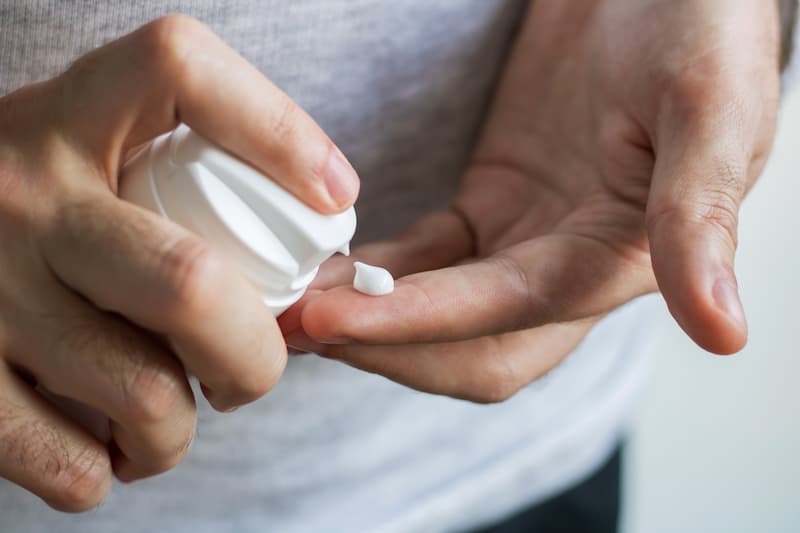How To Heal Track Marks
Track marks are scars that develop after repeated intravenous drug use. Creams and ointments may help reduce swelling for track marks, but there is no definitive treatment for them. You can lower your risk for track marks by cleaning an injection site before use, always using a clean needle, and rotating and changing your injection sites.
What Are Track Marks?
Track marks are scars on the skin that often run the length of veins that have been repeatedly injected into.1 They can be painful and/or itchy and can look discolored, flat, raised, or recessed (pitted below the normal plane of the skin).2
Several factors contribute to the appearance of track marks, including your skin type, age, area of the body they form on, and your overall health.2
Many users start off injecting into the forearms.3 However, repeated IV drug use to one area can lead to scarring, inflammation, bruising, and collapsed veins. When this happens, users will often inject into other parts of the body including the face, feet, neck, hands, and genital area.3
How to Care for Track Marks
There is no instant cure for track marks or bruising. However, swelling and inflammation around the injection site usually resolve on their own within a few days.1
Some resources recommend creams that may reduce swelling. Some needle exchange programs hand these out. You can also make your own using equivalent amounts of Vaseline, Preparation H, and vitamin E lotion. Other common ointments for scars include cocoa butter and aloe vera.4
Preventing Track Marks
Injection habits that can help reduce your risk of track marks include:
- Rotating and changing your injection sites.
- Cleaning the area with an alcohol swab before you inject.
- Using a sterile, clean, and sharp needle each time.
- Using smaller-sized needles.1,4
Syringe services programs provide free, clean needles and a safe place to dispose of dirty needles. They may also provide other services such as screening for HIV and hepatitis C, education on safer injection and wound care, and referrals to substance abuse treatment.5
Other Risks of Injection
The biggest risks of heroin use are overdose and death.
Beyond that, injecting drugs into your body puts you at an increased risk of acquiring infections. Several blood-borne infections are associated with injection drug use, including HIV and hepatitis viruses.
HIV:6
- Can be spread through the sharing of needles and having unprotected sex.
- Has no vaccine or cure, though medicine can reduce the risk of transmission and disease progression.
Hepatitis B and C:6
- Are transmitted through sharing drug paraphernalia, including needles.
- Can be spread through unsafe sexual practices, though this means of transmission is not likely with hepatitis C.
- Lead to painful inflammation of the liver.
- Can lead to progressive liver dysfunction, cirrhosis, and cancer.
- Have medicines available to treat the infection; however, only hepatitis B has a vaccine.
Other infection-related risks from injecting include endocarditis and tuberculosis (TB).
Infective or bacterial endocarditis:4
- Is a heart infection that occurs when bacteria that enter through your veins colonize the endocardial lining of your heart or heart valves.
- Can cause valvular dysfunction and embolisms, which can result in death.
Infection with tuberculosis bacteria can result in active tubercular disease or latent tuberculosis infection. TB spread through the air when someone coughs, speaks, sneezes, or sings.7

Active TB disease:7
- Is a bacterial infection that affects vital body organs, most commonly the lungs.
- Is contagious and symptoms can include cough, weight loss, chest pain, poor appetite, hot and cold flashes, night sweats, coughing up blood, and low appetite.
- Can be fatal if not treated.
Latent TB:7
- Is not contagious and does not cause any symptoms.
- Can exist in the body without causing illness, but can develop into the disease.
“Skin popping” is injecting under your skin as opposed to a vein. Many users resort to this method when their veins are damaged. This practice can lead to cellulitis and abscesses.8
Cellulitis:1
- Is a result of a dermal or subcutaneous bacterial infection that causes skin to appear red and swollen, be sensitive to touch, and feel hot.
- Often occurs in association with abscesses.
An abscess:1
- Is a walled-off collection of pus that develops beneath the skin.
- Is resistant to treatment with antibiotics and often requires incision and drainage of the wound.
- Can become a regular occurrence because bacteria can colonize below the skin after years of IV drug use.
Lastly, heroin is often laced with other additives that can affect your health. Powdered milk, sugar, or starch mixed with heroin can clog the blood vessels that lead to major organs of the body, which can result in irreversible harm to the brain, kidneys, lungs, and liver.9
Getting Clean
While syringe services programs can help prevent infections and track marks, the only way to eliminate your risk of disease or track marks is to stop IV drug use. Seeking treatment for your addiction can be the first step in improving your quality of life and overall health.
Medication-assisted treatment, 12-step programs, inpatient and outpatient programs, and group therapy are some of the common treatment options for heroin addiction. Inpatient and outpatient programs can create a tailored treatment plan to suit your unique needs.
If you are working to quit using IV drugs, there is no better time than now. Call your doctor or insurance provider or begin researching programs online to identify the best treatment option for your situation.
Sources
[1]. World Health Organization. (2008). Management of common health problems of drug users.
[2]. Johns Hopkins Medicine. (n.d.). Scars.
[3]. Minnesota Department of Health. (n.d.). Opioid dashboard: Injection drug use.
[4]. Canadian AIDS Treatment Information Exchange. (2014). Sharp shooters: Harm reduction info for safer injection drug use.
[5]. Centers for Disease Control and Prevention. (2018). Syringe services programs.
[6]. National Institute on Drug Abuse. (2018). Drug use and viral infections (HIV, hepatitis).
[7]. Centers for Disease Control and Prevention. (2016). Questions and Answers About TB.
[8]. American Psychiatric Association. (2013). Diagnostic and statistical manual of mental health disorders (5th ed.). Arlington, VA: American Psychiatric Publishing.
[9]. National Institute on Drug Abuse. (2018). Heroin.
Heroin Rehabilitation Directory
Select a state to learn more about your treatment options.- Alabama
- Alaska
- Arizona
- Arkansas
- California
- Colorado
- Connecticut
- Delaware
- District Of Columbia
- Florida
- Georgia
- Hawaii
- Idaho
- Illinois
- Indiana
- Iowa
- Kansas
- Kentucky
- Louisiana
- Maine
- Maryland
- Massachusetts
- Michigan
- Minnesota
- Mississippi
- Missouri
- Montana
- Nebraska
- Nevada
- New Hampshire
- New Jersey
- New Mexico
- New York
- North Carolina
- North Dakota
- Ohio
- Oklahoma
- Oregon
- Pennsylvania
- Rhode Island
- South Carolina
- South Dakota
- Tennessee
- Texas
- Utah
- Vermont
- Virginia
- Washington
- West Virginia
- Wisconsin
- Wyoming
Help for Heroin Addiction
Do you know someone suffering from heroin addiction? Help is available. To find out more, please choose the selection that applies to you or the person suffering from addiction:
Fill out the form below to be contacted.
Repair the damage and start fresh today!


